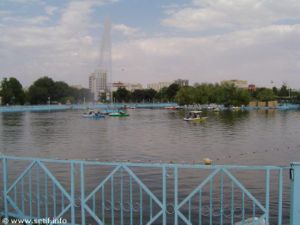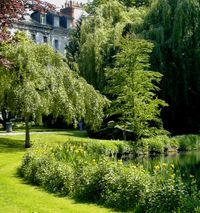Park
2007 Schools Wikipedia Selection. Related subjects: Recreation

A park is any of a number of geographic features.
Public parks

Today, the primary meaning, based on the original meaning, is an area of open space provided for recreational uses. Parks in this sense are usually owned and provided by the government. Park uses are often divided into two categories: active and passive recreation. Active recreation is that which require intensive development and often involves cooperative or team activity, including playgrounds and ball fields. Passive recreation is that which emphasizes the open-space aspect of a park and which involves a low level of development, including picnic areas and trails.
Many smaller neighbourhood parks are receiving increased attention and valuation as significant community assets and places of refuge in heavily populated urban areas. Neighbourhood groups around the world are joining together to support local parks that have suffered from urban decay and government neglect.
A linear park is a park that has a much greater length than width. A typical example of a linear park is a section of a former railway that has been converted into a park (i.e. the tracks removed, vegetation allowed to grow back). Parks are sometimes made out of oddly shaped areas of land, much like the vacant lots that often become city neighbourhood parks.

In the United States the concept of preserving unique landscapes for the pleasure of the people of the entire nation was established on June 30, 1864, when President Abraham Lincoln signed the bill creating the Yosemite Grant. A policy of preservation, rather than co-usage as in the National Forests, where grazing, farming and logging are licensed, was implemented four decades later during the presidential administration of Teddy Roosevelt, and Yosemite became a National Park. Tourism and, later, recreation were the intended purposes of the lands Roosevelt set aside in the system. John Muir was instrumental in this effort. These parks were ultimately termed national parks and today constitute the US National Park System. Similarly, US state governments have also set aside and continue to set aside lands of various sizes to preserve them for the enjoyment of the public. National and regional parks are found in many other countries, and vary greatly in the sort of management and administration which they enjoy. There are also national parks in many other countries; the usage of the term varies greatly from one country to another.
Private parks
Private parks are owned by individuals or businesses and are used at the discretion of the owner. There are a few types of private parks, and some which once were privately maintained and used have now been made open to the public. The concept of the commons is somewhat related to the origin of modern park systems.
Hunting parks originally referred to an area maintained as open space where residences, industry and farming were not allowed, often originally so that nobility might have a place to hunt. These were known for instance, as deer parks (deer being originally a term meaning any wild animal). Many country houses in Great Britain and Ireland still have parks of this sort, which since the 18th century have often been carefully landscaped for aesthetic effect. They are usually a mixture of open grassland with scattered trees and sections of woodland, and are often enclosed by a high wall. The area immediately around the house is the garden. In some cases this will also feature sweeping lawns and scattered trees; the basic difference between a country house's park and its garden is that the park is grazed by animals, but they are excluded from the garden.
In some countries, especially the United Kingdom, the concept of the country park was popular in the 1970s, and many such parks were established with government support during that time. Country parks are often located near to urban populations, and provide recreational facilities typical of the countryside rather than the town.
The term park is also used in reference to industrial areas, often termed industrial parks. Some technology research areas are also called research parks. Small environmental areas, often part of urban renewal plans, are called pocket parks. The word park may also be used in community names, such as Oak Park or College Park. Sometimes the active recreational aspect may be expressed in the extreme of naming an amusement park, usually privately owned. A car park is an area of land or a building in which cars are parked. The majority of these uses refer to private parks.
Notable parks

- Algonquin Provincial Park, Ontario, Canada
- Amstel Park, Amsterdam, The Netherlands
- Balboa Park, San Diego, California
- Banff National Park, Alberta, Canada
- Birkenhead Park, England
- Bois de la Cambre, Brussels, Belgium
- Bosque de Chapultepec, Mexico City, Mexico
- Casa de Campo, Madrid, Spain
- Central Park, Manhattan, New York
- Chain of Lakes Park, Minneapolis, Minnesota
- Death Valley National Park, California
- Denali National Park, Alaska, USA
- Echo Park, Los Angeles, California
- Elysian Park, Los Angeles, California
- Everglades National Park, Florida, USA
- Englischer Garten, Munich, Germany
- Fairmount Park, Philadelphia, Pennsylvania
- Forest Park, Portland, Oregon
- Garfield Park Conservatory, Chicago, Illinois
- Golden Gate Park, San Francisco, California
- Grant Park, Chicago, Illinois
- Griffith Park, Los Angeles, California
- High Park, Toronto, Canada
- Hiroshima Peace Memorial Park, Hiroshima, Japan
- Hong Kong Country Parks
- Humboldt Park, Chicago, Illinois
- Hyde Park, London, United Kingdom
- Hyde Park, Sydney, Australia
- Jackson Park, Chicago, Illinois
- Kaivopuisto, Helsinki, Finland
- Lassen Volcanic National Park, California
- MacArthur Park, Los Angeles, California
- Parks and gardens of Melbourne, Australia
- Mill Ends Park, Portland, Oregon
- Millennium Park, Chicago, Illinois
- Mount Royal Park, Montreal, Quebec
- Nagasaki Peace Park, Nagasaki, Japan
- Greenbelt, Ottawa
- Parks and gardens of Paris, France
- Park von Muskau, Bad Muskau, Germany
- People's Park, Berkeley, California
- Phoenix Park, Dublin, Ireland
- Piedmont Park, Atlanta, Georgia
- Prater park, Vienna, Austria
- Royal Parks of London, England
- Parque Simon Bolivar, Bogotá, Colombia
- Sequoia National Park, California
- St. Stephen's Green, Dublin, Ireland
- Stanley Park, Vancouver, British Columbia
- Sutton Park, Sutton Coldfield, Birmingham, England
- Vondelpark, Amsterdam, The Netherlands
- Washington Park, Chicago, Illinois
- Yellowstone National Park, United States
- Yosemite National Park, California